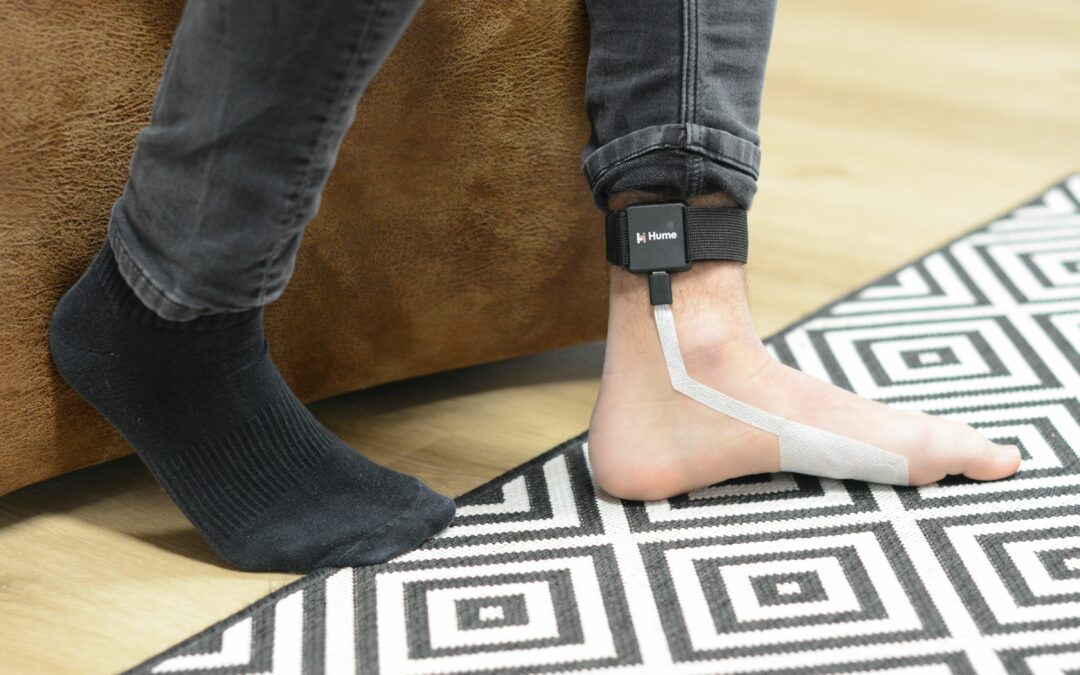Printed electronics has attracted tremendous attention in recent years. Not only because it introduces new possibilities, but also because it includes properties such as flexibility and stretchability, which even enlarge these possibilities. One of the domains where these wider possibilities prove to be very useful is the medical domain.
Here’s one example that says it all.
We have developed, together with the Dutch company Mentech, an electrode patch to measure skin conductance on the feet of clients with severe intellectual disabilities. By measuring skin conductance, which is a key parameter for stress detection, healthcare workers can be notified automatically when a client is getting stressed.
Mentech is the developer of HUME, a streaming software platform for real-time stress detection, based on physiological signals and artificial intelligence models. The sensors measure physiological characteristics such as heart rate, skin conduction and activity. This information is converted into usable information in the HUME-platform by means of behavioral models. This way early stress signals can detect beginning stages of patient anxiety. As these patients often cannot express their emotions with words or gestures, the stress signals notify healthcare workers at an early stage. They are trained to avoid escalation, increasing the quality of life of intellectually disabled persons not having to cope with misunderstood behavior, stress, anxiety, and negative emotions.
In the past, Mentech used wrist bands and smart watches to measure skin conductivity for stress level detection. But for this specific client group of severe intellectually disabled persons, a device worn at the wrist is not a viable solution. Often, these people do not understand why they must wear the device and they could even take it off or break it. A solution that would give more control and certainty was needed. That is why Mentech decided to develop a wearable solution of its own.
Next to that, research showed that the foot is the best place to measure skin conductivity. So Mentech decided to develop a sensor solution that could be easily placed on the sole of the foot, to increase the comfort level of the client. For the development of the electrode patch, Quad Industries was appointed, as we are specialized in the development and production of printed electronics solutions.
We have developed a few smart patch prototypes, differing in material, conductive inks, location on the foot, electrode designs… Bearing in mind the requirements in terms of wearing comfort, stretchability and wearing time we did extensive research on these parameters and selected a few combinations that were iteratively tested on small groups of patients. After that we finetuned and scaled up the initial prototypes. Thanks to SmartEEs funding we were able to flawlessly interconnect the HUME-module with the electrode patch and determine the best position of the module above the ankle.
The early-stage involvement of Quad was crucial for the success of the development. Because the technology of printed electronics is rather new, there are no existing standards that can be prescribed or followed. In the early stages, the co-development between Quad and Mentech on determining needs, applications and requirements was mandatory to develop a winning solution as soon as possible. Co-development for sure has a positive effect on solution quality, time to market and cost efficiency.
This development was the start of an extended collaboration, where Mentech and Quad Industries also developed an ECG chest patch. This electrode patch replaces the traditional chest band, which causes difficulties in terms of wearing comfort and the sensing quality. To assure accurate measurement, the chest band must be stretched firmly across the chest to avoid loss of signal during body movement. Additionally, the chest band can cause skin irritation after multiple hours of use. The chest patch, on the other hand, is small, stays fixed on the wright place and stretches along with the movement of the chest. It allows accurate measurement and excellent wearing comfort, even for people with a deformed chest.
We are also looking at other sensing solutions such as printed electrodes in socks. The big advantage of smart textiles compared to patches is that they can be washed and re-used several times. The evolution of printed electronics on textile allows accurate sensing solutions without wiring and difficult interconnections. The HUME-platform of Mentech allows to combine different sensor solutions. When ECG- and skin conductivity signals are combined, the stress predictions are more accurate and reliable, thus giving a better tool to understand behavior of people with an intellectual disability or dementia.
We as a company are happy to contribute to solutions that improve healthcare and the quality of lives and comfort for both patients and staff. We see a great future for printed electronics in the healthcare industry. If you see a challenge in making your medical application more patient-friendly and you think printed electronics can have a part in this, do not hesitate to contact us. We’ll be glad to think of possible solutions.

